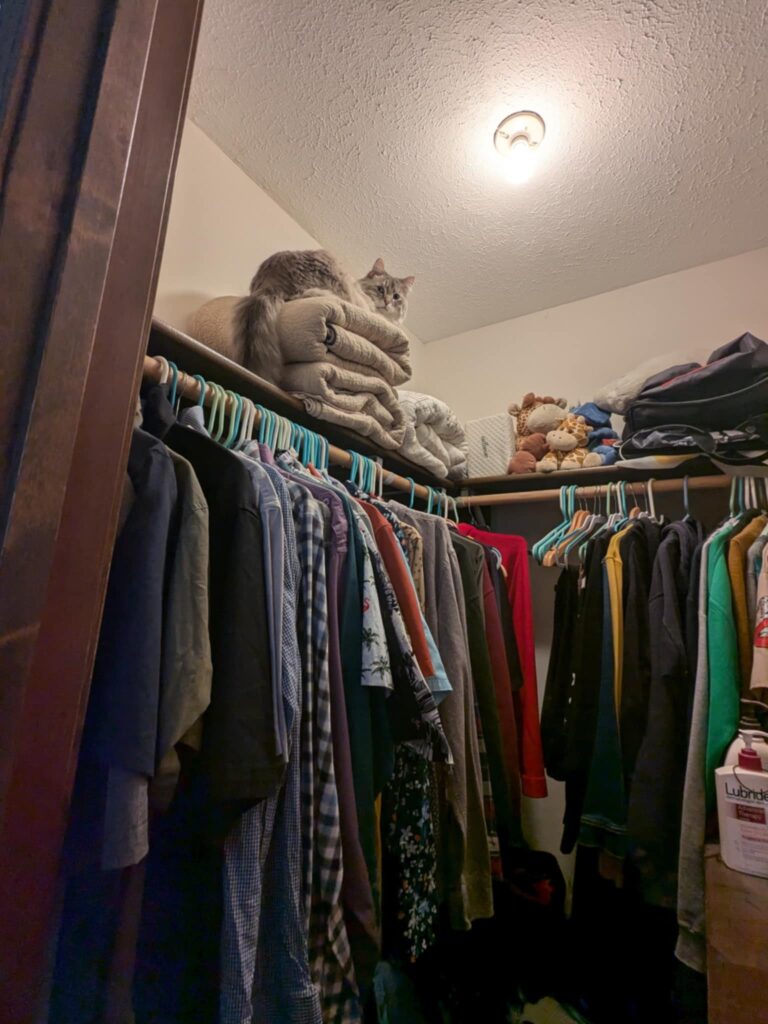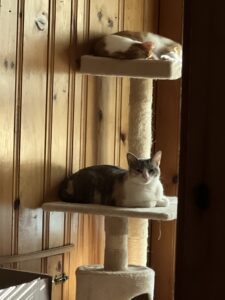Cats, like other sentient beings, can get anxious and/or overwhelmed by their environment and the other beings in it from time to time. And like other sentient beings, if they don’t have a way to escape that chronic stress, it can impact both their physical health and their behavioral health. When I worked with clients I used to tell them that the sustained pressure of living with chronic stress will eventually come out somehow: through explosion, implosion, sublimation, or learned helplessness.
- Explosion looks like conflict-seeking behaviors–like cats fighting each other.
- Implosion looks like self-harming behaviors–in cats, that often looks like overgrooming to the point of damaging their coat and sometimes even their skin.
- Sublimation looks like acting out in seemingly unrelated ways–like peeing in your boots.
- Learned helplessness in cats often looks like a loss of personality and behavioral diversity, just doing the bare minimum to take care of themselves and stay alive.
One of the most impactful things we can do to alleviate that chronic stress and prevent any of those kinds of harm from happening to our kitties is create a dedicated safe space just for them. Whether you’re bringing home a new cat, managing a multi-pet household, or simply supporting a shy or anxious kitty, a well thought out safe space can be the difference between a stressed out cat and one who feels confident enough to explore the world around them and genuinely enjoy their life.
At Pet Harmony, we believe in setting up environments that support the behaviors we want to see. So let’s talk about what a feline safe space looks like, why it’s so powerful, and how you can create one that meets your cat’s unique needs.
What Is a Safe Space for a Cat?
A safe space is a quiet, cozy, and low-traffic area where your cat can retreat, decompress, and feel in control of their surroundings. Think of it as your cat’s personal sanctuary—free from stressors, full of comfort, and of course full of opportunities for cats to meet their own needs.
A safe space can be a whole room – like a guest bedroom – or a designated nook—like a cozy corner with a tall cat tree and a hiding spot. The key is that your cat feels safe there, and that security often comes from choice, control, and predictability.
Why Your Cat Needs a Safe Space
Cats as a species are both predators and prey, which means they can have a tendency to be hyper-aware of their surroundings and therefore can be really sensitive to everything that’s happening around them. Changes in routine, unfamiliar guests, renovations, or even a new smell can be enough of a stressor to set them off kilter.
On top of that, interpersonal dynamics among cats or between cats and other species can be pretty subtle and hard for us to notice, but can function as significant chronic stressors for them. I had a client where the only sign of conflict between two cats was that one would give the other a hard stare when she tried to approach the litter box, water bowl, or food bowl that the first cat was guarding. That look was enough to cause major distress in the second cat that resulted in a urinary tract infection and persistent inappropriate elimination, even after the infection was resolved. I’ve also worked with multiple clients where the source of the cat’s chronic stress was a mystery until we discovered that a stray cat was marking their territory in their yard.
The take-home point is that the source of a cat’s stress isn’t always immediately obvious to us, and they will do better if they have the ability to move away from their stressors on their own. A safe space gives them the choice to step away and complete their stress response cycle.

How to Set Up a Cat-Friendly Safe Space
Let’s break this down into manageable steps so you can set your cat up for success.
1. Choose the Right Location
Pick a quiet area away from high foot traffic, loud appliances, or busy windows. If you live in a bustling household, a guest room or home office with a door that can close is ideal. If space is limited, try using a tall piece of furniture, curtain dividers, or even a modified closet. If the other pets in your home are contributing to the cat’s stress, make sure their respective safe spaces are separated from each other.
2. Add the Essentials
Here’s your feline-friendly checklist:
- Hiding spot: A box, covered bed, or carrier are usually good options to trial and eval.
- Vertical space: A cat tree, shelf, or wall-mounted perch are good, but ideally your cat’s perch will be the highest thing in the room–otherwise, you may find that your cat is just using the vertical space you gave them to access a space that you maybe didn’t want them to access.
- Litter box: In a discreet but accessible spot. Preferably with a ramp or low point of entry so they don’t have to climb a high barrier to get in and out of it.
- Food and water: Placed at a distance from the litter box.
- Toys and enrichment: Interactive toys, puzzle feeders, or a wand toy can all be good options, but if your cat doesn’t currently play with toys you may want to do a play preference test to find out what your cat enjoys. Give them things that they can use to entertain themselves without needing your involvement.
- Comfortable bedding: Something warm and soft that smells like them.
Pro tip: Let your cat choose where they feel safest within that space—observe and support their choices.

3. Make It Smell Familiar
Scent is a huge part of how cats experience security. Place a used t-shirt, blanket, or towel with your scent in the area. If you’re welcoming a new cat, you can try using synthetic feline pheromones like Feliway to help ease the transition, but if you have something of theirs from their previous home that smells like them, that would be ideal.
4. Limit Unwanted Access
Let your cat know this space is theirs. Keep dogs, kids, or other cats out, especially if your feline is stressed or new to the home. Respect their boundaries—this isn’t the place for unsolicited cuddles or surprise visits.
What a Safe Space Is Not
Creating a safe space doesn’t mean isolating your cat or punishing them by locking them away. The goal is to offer choice and control, not confinement. Think of it as empowering your cat to engage with the world at their own pace.
Sometimes that may mean giving them the ability to come and go from their safe space as they please. When that isn’t an option, the next best thing is to figure out your cat’s cues for requesting to go in and out of their space and facilitating their requests. If even that isn’t an option – because we’ve all got lives and we can’t be watching our pets 24/7 – keep an ear out for when your cat is asking to leave their safe space, so they never feel trapped there.
Safe Spaces and Behavior Goals
If you’re working with a behavior professional to address your cat’s distress – like reducing fear, reactivity, or inappropriate elimination – a safe space is often the foundation of your plan. Why? Because learning only happens when an animal feels safe. And just like us, cats can’t thrive if they’re constantly on edge.
If you’ve been following us for any amount of time you have almost certainly heard us say this: Behavior is communication. If your cat is hiding, hissing, or avoiding someone in your household, they may be telling you they don’t feel safe. Meeting that need is the first step toward changing their behavior and improving their physical, behavioral, and emotional health.

Final Thoughts
Whether you’re welcoming a kitten or supporting a senior cat through a big life change, creating a safe space is a gift of agency and care. It tells your cat, “You’re safe here. You’re in control. You get to choose.”
And from that foundation, trust grows. Confidence builds. And your relationship with them blossoms.
Now What?
Need help setting up the perfect safe space for your cat—or navigating behavior challenges? Our team at Pet Harmony offers personalized, evidence-based support to help your pet thrive. Let’s make life easier for you and your feline friend.
Here’s to harmony!
-Emily


